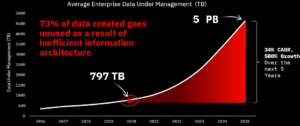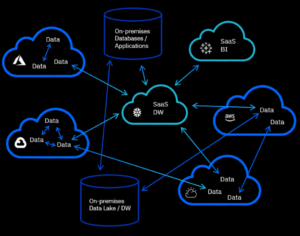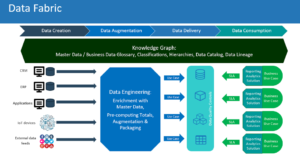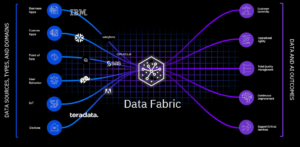73% of data created goes unused as a result of inefficient information architecture. That’s a very expensive and ineffective approach.

For many enterprises today, operational data has largely remained siloed and hidden, leading to an enormous amount of dark data. As organizations seek to leverage their data, they encounter challenges resulting from diverse data sources, types, structures, environments, and platforms. This multidimensional data predicament is further complicated when organizations adopt hybrid and multi-cloud architectures.

What is a Data Fabric?
Data Fabric is an emerging architecture that aims to address the data challenges arising out of a hybrid data landscape. Its fundamental idea is to strike a balance between decentralization and globalization by acting as the virtual connective tissue between data endpoints to:
- Reduce the number of data copies by virtually connecting data endpoints and simplifying access patterns over any data
- Activate global automatic policy enforcement for increased data protection and quality
- Utilize augmentation of integration governance, and active metadata to enable a dynamic, intelligent, and automated data orchestration
- Provide automatic enrichment to contextualize data with semantics and knowledge
Data Fabric is agnostic to deployment platforms, data processes, geographical locations, and architectural approaches. It facilitates the use of data as an enterprise asset. A data fabric ensures your various kinds of data can be successfully combined, accessed, and governed both efficiently and effectively.
How Data Fabric Differs from previous architectures
Data Fabric is a new approach to data management that offers a comprehensive, flexible, and secure environment for data storage and access. It provides a consistent way to access and manage data across different locations and formats, including on-premises and cloud environments. It provides a holistic view of data assets, improves data availability, and simplifies the data management process.

It differs from previous architectures in several ways.
First, Data Fabric provides a layer of abstraction over existing databases and applications, enabling the use of a single platform for the management of multiple data sources. This unified data management allows access and management of data across different locations and formats, including on-premises and cloud environments.
Second, Data Fabric includes a distributed deployment model, which allows for data to be stored and accessed across multiple machines, enabling improved performance and scalability.
Third, Data Fabric offers an application programming interface (API) that enables applications to interact with data sources more securely and efficiently. This allows for more flexibility and control over data access and usage. This unified approach enables businesses to easily share data within their organization and with external partners, improving collaboration.
Finally, Data Fabric provides an integrated analytics platform, allowing organizations to analyze data from multiple sources and create actionable insights. This provides businesses with better insights into their customers, products, and services, and leads to more informed decision-making, improved operational efficiencies, and increased competitiveness.
Why should Businesses adopt Data Fabric?
Data Fabric represents a significant shift in how businesses manage and utilize their data. Providing a unified, automated, and intelligent approach to data management, allows businesses to unlock the full potential of their data assets. It eliminates the need for organizations to build and maintain complex data warehouses and enables them to get the most out of their data.
Data Fabric is the ideal approach for businesses that need to access and analyze large volumes of data from various sources in order to make better decisions. With Data Fabric, businesses can easily integrate data from different sources, including external databases, social media, and IoT devices, and use the data to gain insights into customer behavior, supply chain optimization, and other business processes.
Data Fabric also makes it easier for businesses to leverage the power of predictive analytics. By using data from multiple sources, businesses can gain deeper insights into customer behavior and predict future trends. This helps them develop more effective marketing and advertising campaigns to better engage customers and drive sales.
Data only delivers business value when it is contextualized and becomes accessible by any user or application in the organization. Overall, Data Fabric can help businesses unlock the value of their data.
In summary, Data Fabric offers key benefits:
- Build a data pipeline to enable self-service data consumption and collaboration . (459% ROI)
- Automate governance, protection, and security thru guided decision-making. (430% performance improvement)
- Unlock data by automating data engineering tasks and augmenting data integration across hybrid cloud resources. (60X acceleration in data delivery time)
- Boost efficiency in times of economic uncertainty
Stary your Data Fabric journey with Readiness Assessment.





